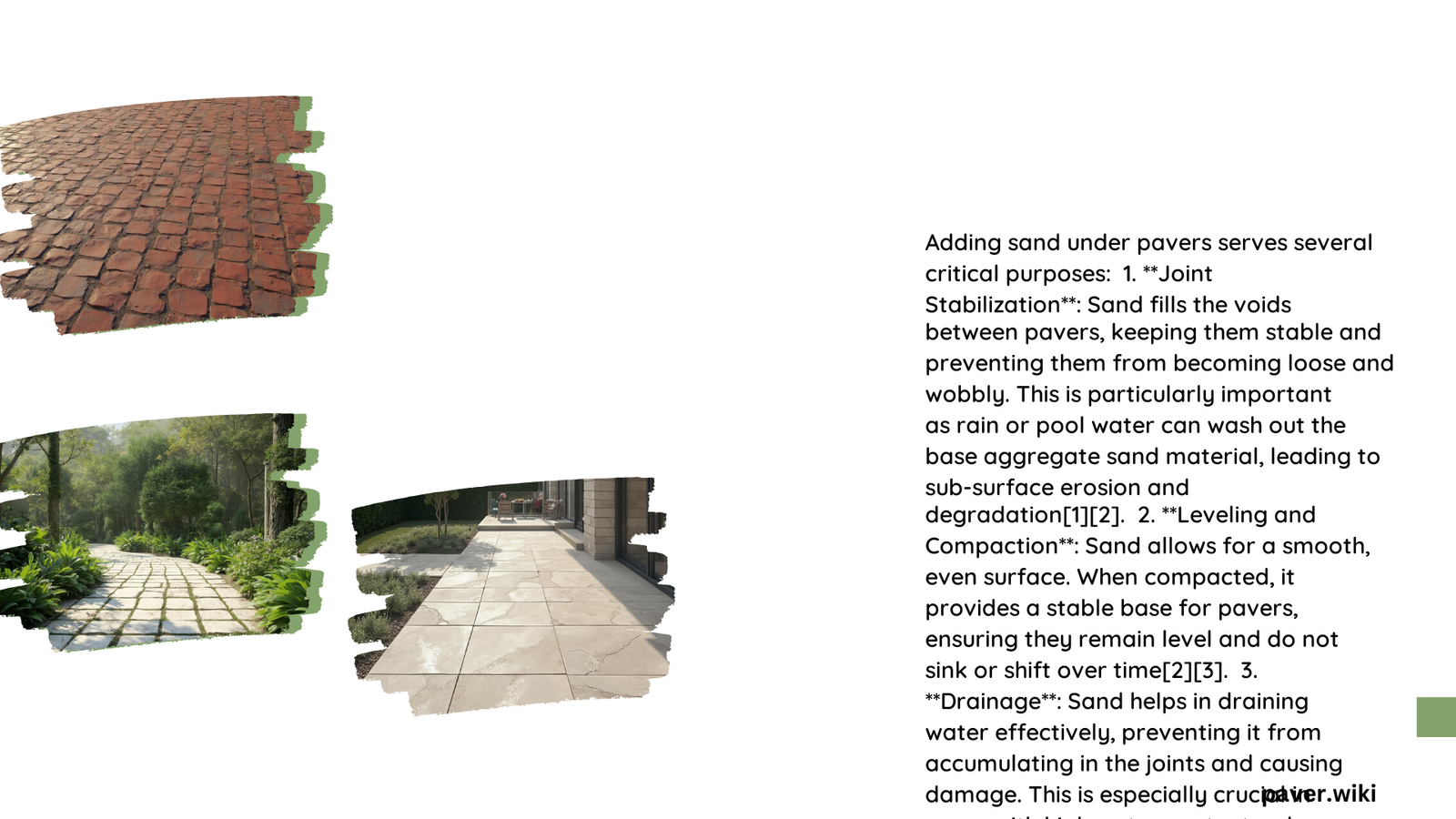Adding sand under pavers is crucial for creating a stable, long-lasting, and aesthetically pleasing paved surface. Sand serves multiple purposes, including providing a level base, enhancing drainage, preventing weed growth, and ensuring proper interlocking of pavers. This comprehensive guide explores the importance of sand in paver installation and maintenance, offering insights into best practices and techniques.
Why Is Sand Necessary Under Pavers?
Sand plays a vital role in paver installation by creating a stable foundation and ensuring proper alignment. Here’s why sand is essential:
- Leveling: Sand provides a smooth, even surface for pavers to rest on.
- Stability: It helps distribute weight evenly across the paved area.
- Flexibility: Sand allows for slight movements without cracking or breaking pavers.
- Drainage: It facilitates water drainage, preventing pooling and potential damage.
What Type of Sand Should Be Used Under Pavers?

Choosing the right type of sand is crucial for a successful paver installation. Here are the main types:
- Bedding Sand: Coarse-grained sand used as the base layer.
- Jointing Sand: Finer sand used to fill gaps between pavers.
- Polymeric Sand: A special type of jointing sand that hardens when wet.
| Sand Type | Grain Size | Primary Use |
|---|---|---|
| Bedding Sand | Coarse | Base layer |
| Jointing Sand | Fine | Gap filling |
| Polymeric Sand | Fine | Gap filling with added stability |
How Much Sand Is Needed Under Pavers?
The amount of sand required depends on the size of your project. Here’s a general guideline:
- Bedding Layer: Typically 1 inch thick
- Coverage: 1 cubic yard of sand covers approximately 300 square feet
- Calculation: (Area in square feet) ÷ 300 = Cubic yards of sand needed
How Does Sand Improve Drainage for Pavers?
Sand plays a crucial role in ensuring proper drainage for paved surfaces:
- Water Absorption: Sand acts as a porous medium, absorbing excess water.
- Channeling: It creates channels for water to flow through and away from the surface.
- Preventing Pooling: Proper sand installation helps prevent water from pooling on the surface.
- Erosion Control: Sand helps minimize erosion of the base material beneath pavers.
What Are the Weed Prevention Benefits of Sand Under Pavers?
Sand, especially polymeric sand, is effective in preventing weed growth:
- Gap Filling: Sand fills spaces between pavers, leaving no room for weeds to grow.
- Hardening: Polymeric sand hardens when wet, creating a solid barrier against weeds.
- Reduced Maintenance: Proper sand application minimizes the need for frequent weeding.
How to Properly Level Sand Under Pavers?
Proper leveling of sand is crucial for a stable and even paver surface. Follow these steps:
- Prepare the Base: Ensure the base layer is compacted and level.
- Add Sand: Spread a 1-inch layer of bedding sand over the base.
- Level: Use a screed board or straight edge to level the sand.
- Compact: Lightly compact the sand to create a firm base.
- Final Check: Use a level to ensure the surface is even before laying pavers.
What Are Common Mistakes to Avoid When Adding Sand Under Pavers?
To ensure a successful paver installation, avoid these common mistakes:
- Using the Wrong Type of Sand: Ensure you use the appropriate sand for bedding and jointing.
- Insufficient Sand Depth: Always maintain a 1-inch bedding layer.
- Over-Compacting: Avoid excessive compaction, which can reduce sand effectiveness.
- Uneven Distribution: Ensure sand is evenly spread across the entire area.
- Ignoring Drainage: Proper sand installation should facilitate, not hinder, drainage.
How Does Sand Contribute to Paver Longevity?
Sand plays a crucial role in extending the life of your paved surface:
- Stability: Provides a stable base, preventing shifting and settling.
- Flexibility: Allows for minor ground movements without damaging pavers.
- Moisture Control: Helps manage moisture levels, preventing damage from freeze-thaw cycles.
- Erosion Prevention: Minimizes erosion of the base material.
- Joint Protection: Fills gaps between pavers, protecting edges from chipping.
What Are the Steps for Adding Sand After Paver Installation?
If you need to add sand after pavers are installed, follow these steps:
- Clean: Remove any debris from paver joints.
- Apply Sand: Spread jointing sand or polymeric sand over the surface.
- Sweep: Use a broom to sweep sand into the joints.
- Compact: Use a plate compactor to settle the sand into the joints.
- Repeat: Add more sand and compact as needed until joints are filled.
- Final Sweep: Remove excess sand from the paver surface.
How Often Should Sand Be Replenished Under Pavers?
The frequency of sand replenishment depends on several factors:
- Weather Conditions: Harsh weather may require more frequent replenishment.
- Traffic: High-traffic areas may need more frequent maintenance.
- Sand Type: Polymeric sand typically lasts longer than regular jointing sand.
- Installation Quality: Properly installed sand may last several years before needing replenishment.
As a general rule, inspect your paved surface annually and replenish sand as needed.
By understanding the importance of sand in paver installation and maintenance, you can ensure a durable, attractive, and long-lasting paved surface. Proper sand application contributes to stability, drainage, weed prevention, and overall longevity of your paver project.
References:
1. NY Pavers – How Much Sand Under Pavers? The Key to a Strong Foundation
2. StoneForensics – The Hidden Secret to Perfect Pavers: The Importance of Sand in the Joints
3. Aviara Pavers – Paver Base vs Paver Sand: What Should You Use
